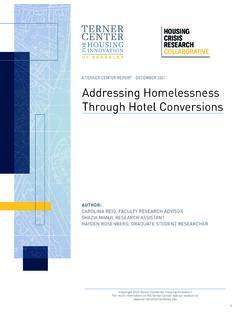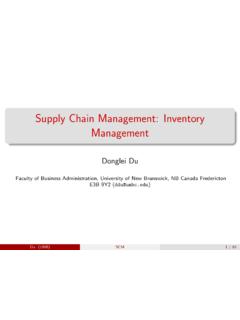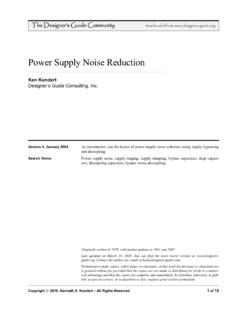Transcription of A TERNER CENTER REPORT - JULY 2021 Will Allowing …
1 Copyright 2021 TERNER CENTER for Housing InnovationFor more information on the TERNER CENTER , see our website at TERNER CENTER REPORT - JULY 2021 Will Allowing Duplexes and Lot Splits on Parcels Zoned forSingle-Family Create New Homes?Assessing the Viability of New Housing supply Under California s Senate Bill 9 AUTHORS:BEN METCALF, MANAGING DIRECTOR, TERNER CENTERDAVID GARCIA, POLICY DIRECTOR, TERNER CENTERIAN CARLTON, CO-FOUNDER AND CEO, MAPCRAFT LABSKATE MACFARLANE, PRODUCT MANAGER, MAPCRAFT LABS A TERNER CENTER REPORT - JULY 20212 IntroductionIn recent years, California lawmakers have proposed a number of legislative changes to address the state s ongoing housing shortage and affordability crisis. While the most ambitious of these efforts have not passed, momentum has increased around one solution in particular: legislation to allow modest increases in smaller-sized units in existing single -family neighbor-hoods.
2 In 2020, Senate Bill 1120 which would have allowed for up to four new homes on existing single -family parcels passed both the California Assembly and Senate, but fell short of becoming law as time ran out at the end of the session. This year, Senate President Pro Tempore Toni Atkins has introduced Senate Bill 9 (SB 9), which proposes a similar policy shift. SB 9 has now passed through the State Senate and is under discussion in the State Assembly; if approved by the Assembly, it may be poised to be the most significant housing bill coming out of California s current legislative session. SB 9 has potential to expand the supply of smaller-scaled housing, particularly in higher-resourced, single -family neighbor-hoods. In this way, SB 9 builds on recent state legislation that opened up access to accessory dwelling units (ADUs) for virtu-ally all California single -family parcels.
3 What distinguishes SB 9 is that it allows for the development of new, for-sale homes, either on a newly subdivided lot or through the conversion of existing single -family homes into multiple units. This ability to create duplexes and/or split the lot and convey new units with a distinct title would allow property owners to pursue a wider range of financing options than are available for ADU construction to build these new In so doing, SB 9 could open up new homeownership oppor-tunities at more attainable price points for prospective purchasers, who would be able to apply for a traditional mortgage to buy the , the likelihood of creating new housing and homeownership opportunities as a result of SB 9 largely depends on local context. While Senate Bill 9 does not apply to single -family parcels in historic districts, fire hazard zones, and rural areas, local market prices and develop-ment costs play a large role in determining where there is financial viability for the addition of new homes.
4 Moreover, phys-ical constraints, such as small lot sizes and other local regulations, can limit the number of new homes built as a result of this bill. To assess the potential impact of SB 9 on new housing supply , this anal-ysis assesses the market feasibility of new homes as allowed by the current version of the Bill (as of July 2021).2 This analysis finds that SB 9 s primary impact will be to unlock incrementally more units on parcels that are already financially feasible under existing law, typically through the simple subdivision of an existing structure. Relatively few new single -family parcels are expected to become financially feasible for added units as a direct consequence of this bill. While this analysis does not attempt to measure the actual rate of uptake for adding new units to single -family parcels, it is reasonable to assume that SB 9 will modestly accelerate the addition of new units relative to the status quo by facilitating access to conventional mortgage products for multiple households able to purchase homes on newly subdivided single -family parcels.
5 A TERNER CENTER REPORT - JULY 20213 BackgroundCalifornia s recent housing laws have largely failed to unlock significant housing production changes that would ease the ongoing housing and homelessness crisis. One of the state s more effective housing solutions has been recent laws removing barriers to the construction and financing of ADUs. In 2016, Senate Bill 1069 and Assembly Bill 2299 expanded the ability of homeowners to build ADUs and Junior ADUs (JADUs). Subsequent legislation (Assembly Bill 68, Assembly Bill 881, Senate Bill 13) removed other barriers to ADU development, including lowering impact fees and removing owner occupancy requirements. The impacts of this legislation are already apparent throughout the state. Published state data demonstrates that the initial 2017 ADU law had immediate impacts: California jurisdictions went from issuing 5,911 ADU permits in 2018 to 15,571 in 2019, with ADU completions following a similar upward trend, more than tripling over the same period (from 1,984 to 6,668 units) (Figure 1).
6 3 The ADU laws that took effect in 2019 Allowing two ADUs on single -family parcels and more on multi-family parcels are already having a significant impact on gently adding density across the state in single - and multi-family properties. In early 2021, the City of Los Angeles reports processing upwards of 20,000 ADUs where ADUs make up nearly 40 percent of all housing building permits, and the City of San Jose reports that ADUs make up 38 percent of all housing building This progress signals the significance of easing approvals and barriers to smaller-scale, infill development in low-density areas. Figure 1. ADU Permits and Completions in California, 2018 and 201902,0004,0006,0008,00010,00012,00014, 00016,00018,000 PermitsCompletions20182019 Source: Chapple, K., et. al. (2020). Reaching California s ADU Potential: Progress to Date and the Need for ADU Finance.
7 Retrieved from: TERNER CENTER REPORT - JULY 20214 The early success of recent ADU legisla-tion has prompted lawmakers to examine similar policies that would incrementally unlock more homes in low-density urban infill neighborhoods where the housing crisis is particularly acute. Such poli-cies would also align with state climate change policies encouraging additional homes near jobs and services to reduce vehicle miles travelled. Last year, SB 1120 proposed Allowing up to four units in single -family-zoned parcels throughout the state. Analysis by the TERNER CENTER of SB 1120 found that nearly six million single -family parcels statewide would theoretically be eligible, a significant expansion of buildable area in For example, if just 5 percent of those parcels created new two-unit structures as a result of SB 1120, that would have resulted in 597,706 new homes.
8 That s more than five times the number of new homes that have been built in California annually since However, in a session marked by the disruptions related to the COVID-19 pandemic, SB1120 ran out of time to be sent to the governor s desk, despite passing both the Assembly and the 9 was introduced with nearly identical language to its predecessor, SB 1120, but as the bill has progressed through the legisla-tive process, some important changes have been made. Most notably, properties that have developed an ADU are not eligible for the density or lot split provisions of SB 9, and jurisdictions would have the option of imposing owner-occupancy requirements for lot split applicants, where the applicant would have to make one of the units on the site their primary residence for at least one year. This owner-occupancy provision has been added to address concerns that current homeowners could be incentiv-ized to sell to private entities interested in speculative investment on single -family parcels and to encourage use of the law to create more opportunities for California families to buy a home.
9 The provisions also ensure the law cannot be used to divide homes occupied by renters as a measure to prevent displacement. Other new provi-sions have made the legislation potentially more impactful. For example, SB 9 allows more flexibility in how the lot is split. SB1120 required that both newly created lots be of equal size, potentially limiting the number of instances where new homes would be feasible. New language in SB 9 requires that one of the newly created parcels only needs to be more than 40 percent of the original parcel size. Table 1 summarizes the key provisions of SB 9 as of July TERNER CENTER REPORT - JULY 20215 Location The parcel, lot, or development must be located in a single -family residential zone. The parcel cannot not be located in a historic district or be a historic property itself (as defined by the state or local county or city).
10 The parcel cannot be located in a high fire zone area. The parcel must be in a city whose boundaries include some portion of an urbanized area or urban cluster as designated by the Census Bureau. If the parcel lies in an unincorporated area, then the parcel at stake must be a legal parcel wholly within the boundaries of an urbanized Size The parcel must be a minimum of 2,400 square feet in size. The newly created parcel as a result of a lot split may not be smaller than 40 percent of the lot area of the original parcel. A locality cannot impose any standards that would preclude the construction of up to two units or physically precluding either of the two units from being at least 800 square feet in floor area. A side and rear setback of up to four feet is The lot split cannot require the demolition or alteration of a housing unit currently serving moderate-, low- or very-low income household(s) or a rent-controlled unit.




